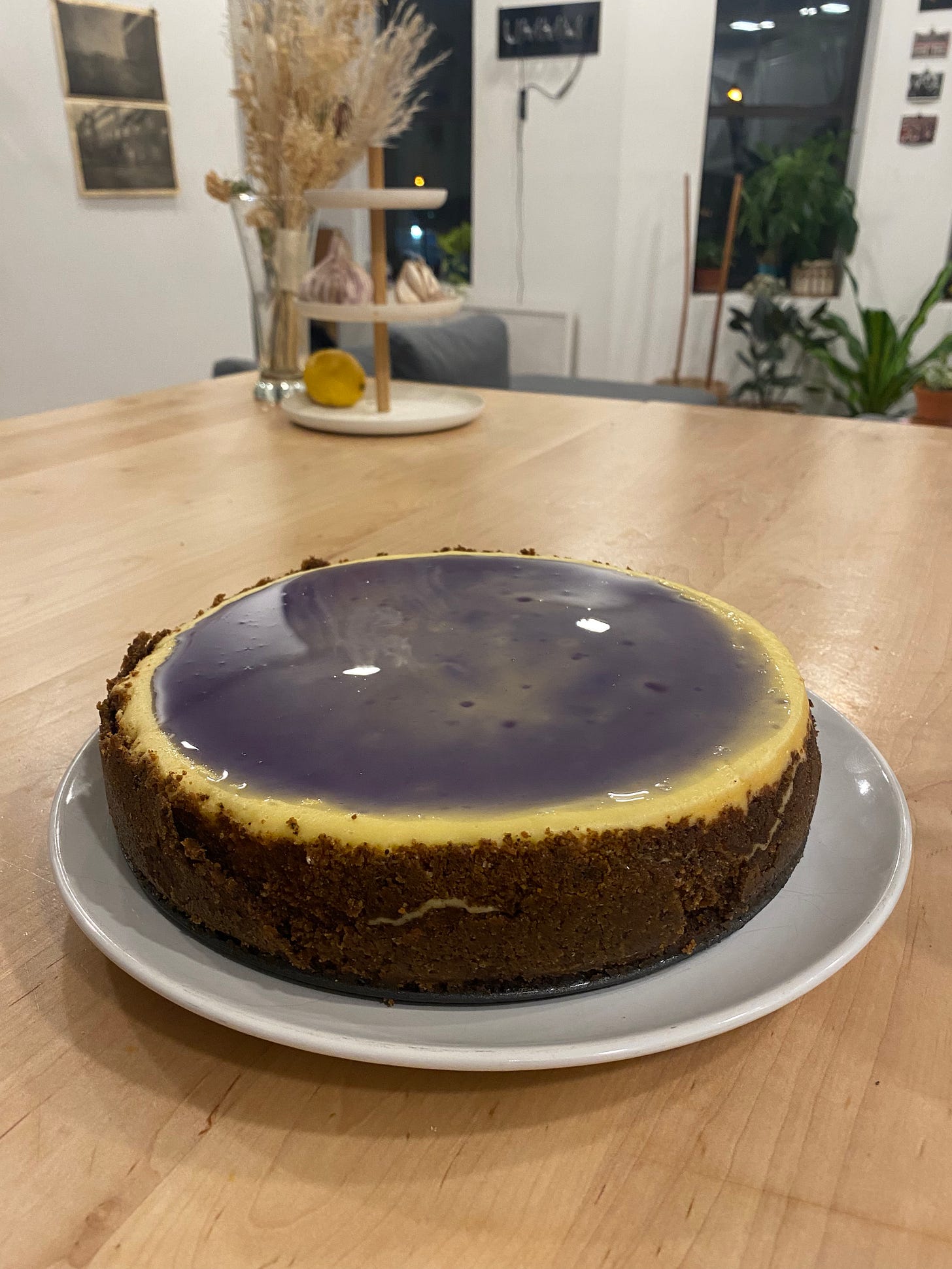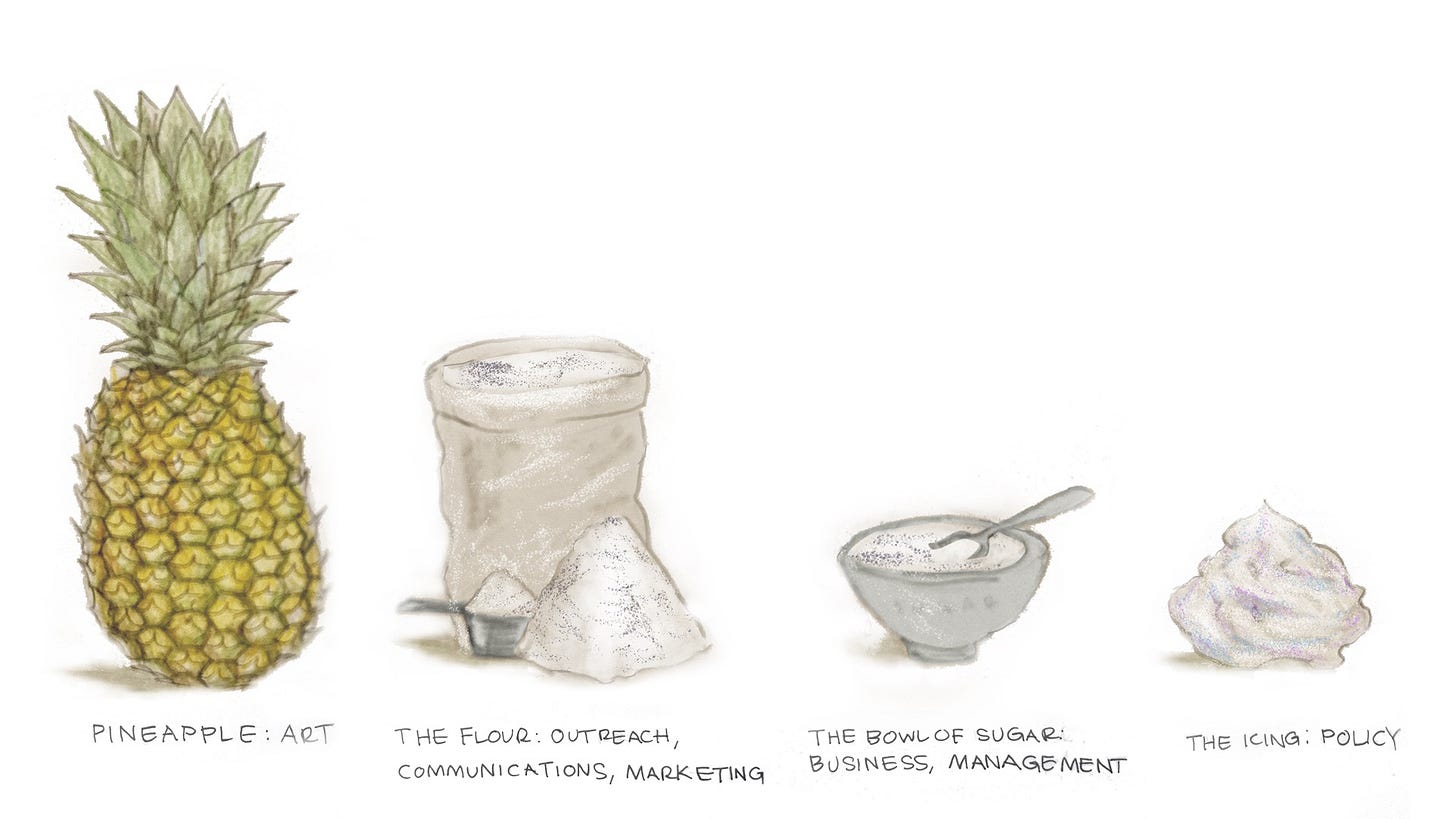Recipe 01: community strategy is delish
Let's define some terms, shall we?
Although there are a few helpful guides for community strategy, I always end up using a recipe metaphor to clients, artists, and friends when they don’t know what it really means. To me, community strategy helps build solutions to community needs by mixing seven skillsets together: outreach, communications, marketing, art, business, management, and policy.
Take cake. Cakes bring people together, celebrate an occasion, and can be made and cut so that everyone gets their favorite slice. Cakes can be gluten-free, dairy-free, nut-free, even sugar-free—custom-designed for everyone at the table.
Yet even after my own journey of baking at least two dozen cakes in the past three years, making a cake can suck. I need to know so much up front, because if I don’t, winging it leads to bad, bad, bad things. How many people are eating it? What dietary restrictions do we have? What’s the occasion for? Where’s my scale? What happened to all my butter? And what in the hell is a water bath?
One thing I’ve learned after interviewing artists like Tony Patrick, Kate Levy, Shanna Merola, and Steve Locke is that if we really care about our communities—the people who support us emotionally, financially, physically, and spiritually—we should spend more time thinking about what they need and how they can get it before we rush in to “solve” something. That’s why community strategy is just like building a recipe to ensure you’re doing the right thing, at the right time, for the right reason.
Get ya apron on
To understand community strategy, we must understand its specific ingredients first in order to fully consider who will be at our table, what they need, and how we can offer something for them—whether it’s an app, a book, an event, a program, a mural, or a product.
Here’s what my community strategy is currently made of:
3 cups outreach:
Who is in our community? The wider our scope, the better.
What do they need? Let them speak for themselves.
What can we offer that meets or solves their needs?
1 tbs communication:
What language makes our offering tangible to our community?
1 tbs marketing:
How will our community find out about what we’re offering to them?
1 business plan (store bought is fine):
What does success look like to us?
What’s our budget?
How will we pay for it?
1 cup art (chef’s choice):
How can creativity give our offering flavor, depth, and individuality?
2 cups project management:
How will we keep track of tasks, goals, and time?
1 cup program management:
How will we meet our community, physically and virtually?
How can we encourage dialogue and feedback?
1/2 cup public policy:
Does the thing we made actually solve our community’s need?
If it solves something else, do we pivot our original intentions?
Here’s my recipe:
Mix the outreach, comms, and marketing teams together.
If these teams don’t synch goals and intentions from the start, we’re going to have competing language that define what we’re doing, why we’re doing it, and for whom we’re doing it.
AKA: without sifting our dry ingredients, our dough won’t be even and might not even rise.
Build the business plan.
It should be informed by the language we’ve agreed upon across outreach, comms, and marketing.
Like eggs or an egg substitute, our dough won’t have a lot of structure without a business plan.
Identify the project managers, program managers, and artists.
They’re the glue that keeps our strategy and plan intact, exciting, and worth paying attention to.
As artist Steve Locke said, “The only thing I can really do as an artist is make you pay attention. If I can make you pay attention, I believe I can change your mind. I really do. Otherwise I wouldn’t be doing this job.”
Just like melted sugar, butter, and flavoring (Pineapple! Rum!), managers and artists are essential to keep things intact and delish. Without them, we’ll be serving a bland, dry pile of dough.
Bake!
That means: spend the right amount of time across each team to work toward our final product. More on this in another newsletter…
When it’s out of the oven, add the public policy.
Like a hypothesis, we double-check the final product to see if it solves what we actually thought it would. Sometimes our offering comes out different than we intended (too sweet, too dry). We reflect, reconsider, and adjust to give it the last final coat.
Think of public policy as the glaze, cream, or icing. Without it, we sometimes lose sight of what brought us together in the first place—trying to solve a community need—and we’re left with something half-baked (or half-done). A policy lens ensures we see our own through line and present what we’ve made honestly.
So far, I’ve used this style of work in for-profit (artist publications), non-profit (billboards), and advocacy (worker rights) projects to pretty solid success. That said, if you want more specific examples of community strategy, Feverbee’s guide is great from tech, for-profit, and social media perspectives. I also like the Community Tool Box’s guide if you’re looking for a grassroots community organizing perspective.

For fun
Thanks for reading. If you want to talk more about community strategy, just reply to this email. To close, I have some haughty alt-titles for my nonexistent book I will definitely not write about this topic:
Easy Bake Oven as Community Strategy Praxis
Community strategy: or, the decolonial reclamation of “let them eat cake”
Abundance mindset, community strategy, and putting too much rum in the icing: lessons from an artist trying to make gluten-free pineapple rum cake for the third time
xx
Second drawing caption: Kiki Eberhardt, Ingredients for a pineapple cake (pencil on paper), 2022.




